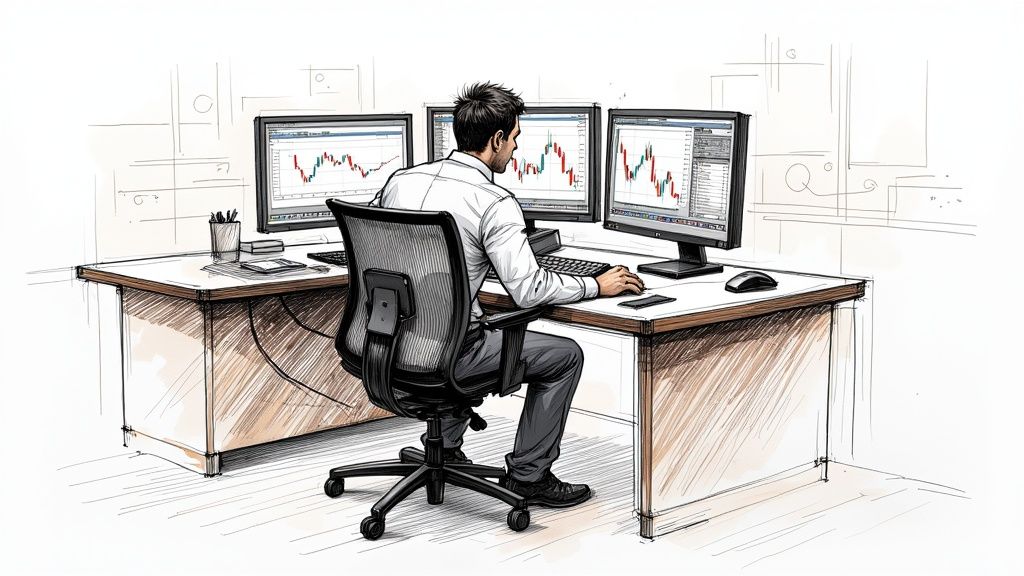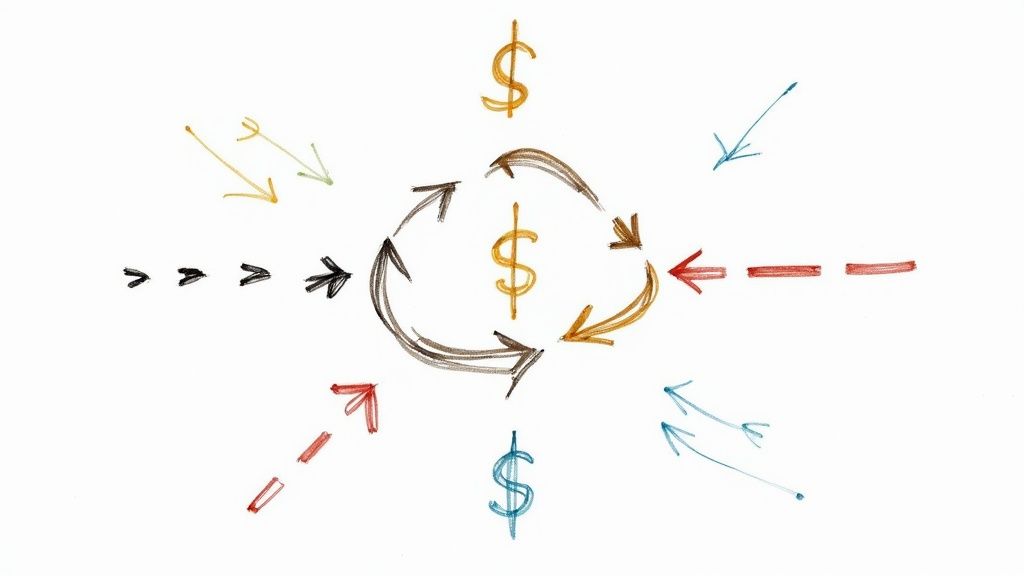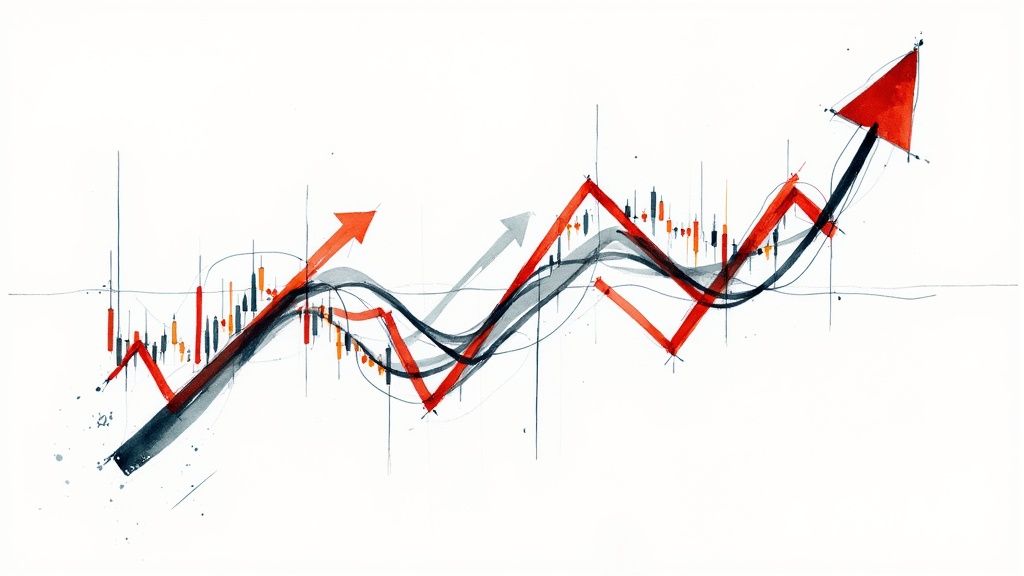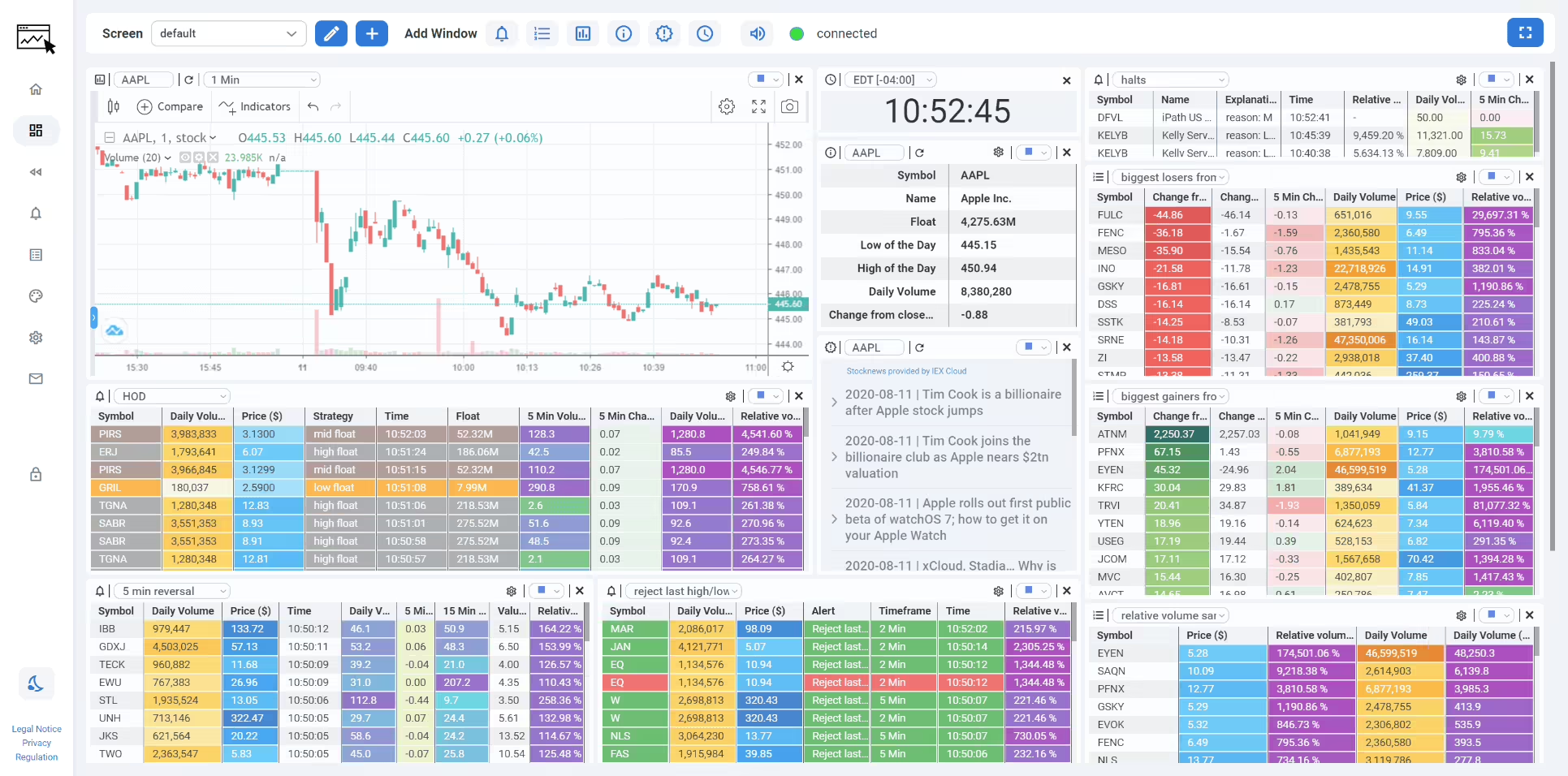Day Trading 101: Unlock Winning Strategies
Breaking Into Day Trading Without Losing Your Mind

The fast pace and potential profits of day trading can be very appealing. But success requires more than quick reflexes and good luck. You need a solid plan, deep market knowledge, and most importantly, the right mindset. Let's explore how to start day trading while keeping your sanity intact.
First Year Focus: Learning, Not Earning
Your first year should be about education, not chasing big profits. Focus on understanding how markets work, testing different strategies, and mastering risk management basics. Think of it like learning any complex skill - you need to crawl before you can walk. Spend time studying price patterns, practicing with paper trading accounts, and creating your personal trading framework.
Structuring Your Trading Day: Routine is Key
Top traders follow strict daily schedules. A typical day might start with pre-market research to spot opportunities, then active trading during peak hours, and end with performance review. For example, you could spend 7-8 AM analyzing news and data, trade from 8-11 AM, and use 11-12 PM to review your trades and update your plan. Having set times for each activity helps maintain discipline and prevents mental fatigue.
Developing Sustainable Practices: The Long Game
Building good trading habits takes time and consistency. Set realistic targets, stick to your risk limits, and keep learning as markets change. Online platforms have made trading more accessible than ever. In fact, the percentage of Americans trading stocks jumped from 15% to 25% between 2019-2021, partly due to remote work during COVID-19. See the full statistics here. With more traders entering the market, having a sustainable long-term approach becomes even more important.
Types of Trading Styles: Finding Your Fit
Day trading isn't one-size-fits-all. Different styles suit different personalities, risk tolerances and account sizes. Here's how the main approaches compare:
| Trading Style | Time Horizon | Risk Level | Capital Required |
|---|---|---|---|
| Scalping | Seconds to Minutes | High | Low to Medium |
| Momentum Trading | Minutes to Hours | Medium to High | Medium |
| Swing Trading | Days to Weeks | Medium | Medium to High |
Understanding these styles helps you pick an approach that matches your goals and trading style. Take time to try different methods and see what works best for you before committing to one strategy.
The Truth About Day Trading Success (And Failure)
Most people imagine day trading as a path to quick riches and financial independence. However, the reality is quite different. Let's examine what actually determines success and failure in day trading, while setting clear expectations based on real data and proven strategies.
Why Most Day Traders Struggle
Many people jump into day trading without proper preparation, underestimating both market complexity and emotional challenges. Common pitfalls include poor understanding of technical analysis, weak risk management, and difficulty handling the psychological stress of trading. These factors often lead to impulsive decisions and mounting losses.
The Path to Profitability: Lessons From Successful Traders
While most traders face difficulties, some consistently succeed. These profitable traders share key characteristics:
- Strong risk management discipline
- Clear trading plans and strategies
- Commitment to ongoing education
- Focus on specific market segments
- Professional approach to tracking results
They treat trading like running a business - carefully monitoring performance, analyzing both wins and losses, and continuously improving their methods based on data.
Setting Realistic Expectations: The Long-Term View
New traders often fall into the trap of expecting overnight success. The truth is that consistent profitability takes time and practice to achieve. Even experienced traders face losses - it's an unavoidable part of the process.
Research supports this reality. A comprehensive study of day traders in Taiwan between 1992-2006 found that only 19% of high-volume traders (trading over $20,000 daily) earned positive returns after fees. Learn more about the study findings.
Success requires adopting a long-term mindset focused on steady improvement rather than quick gains. View setbacks as learning opportunities to refine your approach.
Proven Practices for Consistent Success
Top traders rely on several key practices to maintain their edge:
- Using tools like ChartsWatcher to efficiently analyze markets
- Creating custom dashboards to track critical data
- Setting strict stop-losses to protect capital
- Developing emotional control techniques
- Taking regular breaks to maintain focus
- Stepping away when emotions run high
By combining these practices with dedication to learning and adapting, traders can build a foundation for lasting success in the markets.
Building Your Trading Command Center

Setting up an effective workspace is one of the most important first steps in day trading. A well-organized trading command center helps you make quick decisions based on real-time information. When designed properly, your setup minimizes distractions and helps you respond rapidly to market changes.
Creating an Ergonomic and Efficient Workspace
The physical setup matters more than most traders realize. Start with a good quality chair that supports proper posture and monitors positioned at eye level. An ergonomic keyboard prevents wrist strain during long trading sessions. Keep your desk tidy and organized, with essential tools within easy reach. A clean, comfortable workspace helps maintain focus when markets get hectic.
Choosing Essential Trading Tools and Data
Your core trading tools need to include a reliable trading platform with live data feeds. Look for key features like customizable charts, multiple order types, and real-time news. ChartsWatcher offers flexible window layouts so you can monitor different market aspects simultaneously. Having the right platform setup makes a huge difference in trade execution. For more setup ideas, check out: 10 Best Day Trading Setups: Top Platforms for Success.
Adding Advanced Analysis Tools
Beyond basic charting, consider tools that give you an edge. Market scanners help identify trading opportunities based on your criteria. Technical analysis software spots patterns in price action. Historical data from sources like Cboe Global Markets provides valuable context for current market conditions. The right combination of tools helps you find and analyze potential trades more effectively.
Setting Up for Fast Trade Execution
Quick trade execution is critical for day trading success. Configure your platform for rapid order entry and modification. Hotkeys speed up common trading actions. Multiple monitors let you view charts, news, and order entry simultaneously. This comprehensive view helps you assess conditions and act decisively. The goal is to minimize the time between spotting an opportunity and placing your trade, especially in fast-moving markets where seconds count.
Crafting Your Personal Trading Blueprint

Building a successful day trading strategy starts with creating your own unique approach. Rather than copying others, focus on understanding your personal trading style, comfort with risk, and financial targets. Let's explore how to develop a trading plan that works for you.
Identifying Your Edge in Day Trading 101
Your trading edge is what gives you an advantage in the market. This could be your skill at reading specific chart patterns, expertise in certain market sectors, or ability to stay disciplined under pressure. For instance, some traders excel at spotting sudden price moves in tech stocks, while others find success making small profits in calmer markets. Finding your edge takes honest self-reflection and testing different methods.
Developing Your Trading Setups
After discovering your edge, build trading setups that match your strengths. A setup includes specific market conditions that signal a potential trade. Each setup should clearly define when to enter, exit, and cut losses. This structure helps prevent emotional decisions during live trading. For example, if you're good at spotting momentum shifts, your setup might focus on stocks showing sudden volume increases and price breakouts.
Adapting to Changing Market Conditions
The market constantly changes, so flexibility is key. Successful traders regularly review their results, adjust their approach, and learn from both wins and losses. A strategy that works in high volatility may need changes when markets calm down. Tools like ChartsWatcher can help analyze market conditions and identify needed strategy adjustments.
Position Sizing and Risk Management: Protecting Your Capital
Smart risk management is essential for long-term success. Position sizing determines how much money you put into each trade. Most traders limit risk to 1% of their account per trade to protect against big losses. Stop-loss orders automatically close trades that move against you, adding another layer of protection.
| Metric | Description | Recommended Range |
|---|---|---|
| Risk per Trade | Percentage of capital risked on a single trade | 0.5% - 1% |
| Stop-Loss | Predetermined price level to exit a losing trade | Based on technical analysis and volatility |
| Win Rate | Percentage of winning trades | Varies by strategy, but aim for consistency |
| Risk/Reward Ratio | Potential profit compared to potential loss | Target a minimum of 1:1, ideally higher |
Trade Planning: Preparing for Success
Good preparation is crucial for day trading success. Create a daily trading plan that outlines your target setups, entry and exit points, and risk limits. This keeps you focused and helps avoid impulsive decisions. Think of your trading plan as a map that guides your market decisions. Consider using ChartsWatcher to organize your trading day effectively. The time spent planning is just as important as the actual trading.
Mastering the Mental Game of Trading
The real challenge in day trading isn't just about analyzing charts - it's about managing your mind. Success requires staying composed when markets get volatile. Let's explore practical ways to handle emotions, stick to your strategy, and bounce back from losses.
Controlling Your Emotions: The Key to Rational Decisions
Your emotions can sabotage your trading if you let them. Fear might keep you from good trades, while greed can push you into risky ones. The key is recognizing what triggers these feelings and having a plan to manage them. Simple techniques like deep breathing, taking short breaks, or visualizing successful outcomes can help you stay focused and make clear decisions based on your strategy rather than impulse.
Maintaining Discipline: Sticking to Your Plan
A solid trading plan is your foundation for success. Your plan should clearly spell out when to enter and exit trades, how much risk you'll take, and how you'll size your positions. Think of it as your roadmap - it guides your decisions and keeps you from making random trades. Remember that consistent results come from following your rules, not just having a few winning trades. Learn more about risk management in our guide on How to master day trading risk management.
Recovering From Setbacks: Learning From Losses
Every trader faces losses - it's part of the business. What matters is how you respond to them. Instead of getting discouraged, treat losses as chances to improve. Review what went wrong, adjust your approach if needed, and focus on executing better next time. The best traders know that adapting and learning from mistakes is essential for long-term success.
Building Mental Toughness: Developing Resilience
Trading requires mental strength to handle the daily ups and downs. This means staying positive, focusing on the process instead of just results, and keeping a long-term view. Just like athletes train their bodies, traders must train their minds. Regular mindfulness practice, good health habits, and connecting with other traders can help you develop the mental strength to stay steady through market swings.
Tools and Resources for Mental Mastery
There are many resources available to strengthen your trading mindset. Start with books and courses on trading psychology to build a strong foundation. Tools like ChartsWatcher can help organize your trading and keep you on track. Building mental toughness takes time and practice, but with the right resources and consistent effort, you can develop the psychological skills needed for trading success.
From Paper to Profits: Your First Live Trades

Starting real trading after practicing with simulations is a major milestone. You'll need solid preparation, strict discipline, and an eagerness to keep learning. Here's how to make that transition safely and confidently.
Essential Pre-Trade Preparations
Before your first real trade, get your foundation in place. You need a detailed trading plan that spells out your strategies, entry and exit points, and risk limits. Make sure you have your brokerage account funded and know your trading platform inside and out. Being comfortable with order types, charts and other tools will help you act quickly when markets move.
Managing Risk in Live Trading
Risk control is crucial when trading real money. Many traders follow the 1% rule - never risk more than 1% of your account on a single trade. For a $10,000 account, that means limiting potential losses to $100 per trade. Always use stop-loss orders to automatically close positions at set prices and prevent big drawdowns.
Executing Your First Live Trades
With preparation done, it's time to start trading for real. Begin with small positions in a few carefully chosen stocks that match your strategy. Don't get distracted by market noise or let emotions drive decisions. Stick to your plan and monitor positions closely. Tools like ChartsWatcher can help track key metrics and make smart choices under pressure.
Post-Trade Analysis
Every trade teaches valuable lessons, whether you win or lose. Review each day's trades - study your entries, exits and how well you followed your strategy. Look for ways to improve and update your approach. Keep detailed notes about market conditions, your trade logic, and how you felt during trades.
Scaling Your Trading Activity
As you gain experience and consistent results, you can gradually increase position sizes. But don't rush to scale up. Keep following your risk rules strictly and keep refining your methods. Use ChartsWatcher to effectively monitor more positions as you expand. Remember that building a sustainable trading business takes time and discipline.
Ready to start trading live? ChartsWatcher gives you the tools to analyze markets, control risk, and execute trades efficiently. Sign up now to access professional-grade trading features.

